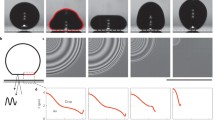Abstract
An experimental study was done to observe the formation of thin films by spraying liquid onto a solid surface and to determine the conditions under which the films would rupture or remain stable. Water, or water mixed with 20–70 % by weight of glycerin, was sprayed for varying lengths of time onto a circular, 165-mm-diameter plate made of either Plexiglas, steel, or Parafilm-M and the motion of the liquid recorded using a high-speed camera. Water films ruptured immediately after the impact near the center of the surface. Then, if the film thickness was greater than a critical value, the water flooded back and the hole closed; otherwise, the hole remained in the water layer. The critical film thickness increases linearly with advancing liquid–solid contact angle. Increasing liquid viscosity by adding glycerin had little effect on critical film thickness, but inhibited spreading of the liquid and suppressed initial rupture of the liquid layer. A surface energy model was used to predict the variation of critical film thickness with surface wettability.










Similar content being viewed by others
References
Dhiman R, Chandra S (2008) Rupture of radially spreading liquid films. Phys Fluids 20:092104
Dhiman R, Chandra S (2010) Rupture of thin films formed during droplet impact. Proc R Soc A 466:1229–1245
Dow Chemical (2010a) Density of glycerine-water solutions. DOW safety data sheets. http://msdssearch.dow.com/PublishedLiteratureDOWCOM/dh_0032/0901b80380032282/pdf?filepath=glycerine/pdfs/noreg/115-00656.pdf&fromPage=GetDoc. Accessed May 2010
Dow Chemical (2010b) Viscosity of aqueous glycerine solutions. http://www.dow.com/safechem/optim/optim-advantage/physical-properties/viscosity.htm. Accessed May 2010
Kheshgi HS, Scriven LE (1991) Dewetting: nucleation and growth of dry regions. Chem Eng Sci 46:519–526
Khossravi D, Connors KA (1993) Solvent effects on chemical processes. 3. Surface tension of binary aqueous organic solvents. J Solut Chem 22:323–328
Mulji N, Chandra S (2010) Rupture and dewetting of water films on solid surfaces. J Colloid Interface Sci 352:194–201
Padday JF (1970) Cohesive properties of thin films of liquids adhering to a solid surface. Spec Discuss Faraday Soc 1:64–74
Redon C, Brochard-Wyart F, Rondelez F (1991) Dynamics of Dewetting. Phys Rev Lett 66:715–718
Sharma A, Ruckenstein E (1989) Dewetting of solids by the formation of holes in macroscopic liquid films. J Colloid Interface Sci 133:358–368
Taylor GI, Michael DH (1973) On making holes in a sheet of fluid. J Fluid Mech 58:625–639
Author information
Authors and Affiliations
Corresponding author
Rights and permissions
About this article
Cite this article
Kadoura, M., Chandra, S. Rupture of thin liquid films sprayed on solid surfaces. Exp Fluids 54, 1465 (2013). https://doi.org/10.1007/s00348-013-1465-y
Received:
Revised:
Accepted:
Published:
DOI: https://doi.org/10.1007/s00348-013-1465-y




